Tao Han
Linda
Mesh-RFT: Enhancing Mesh Generation via Fine-grained Reinforcement Fine-Tuning
May 22, 2025
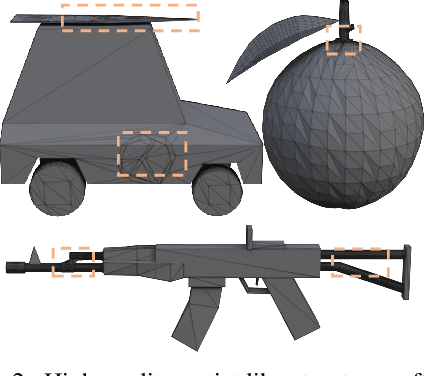
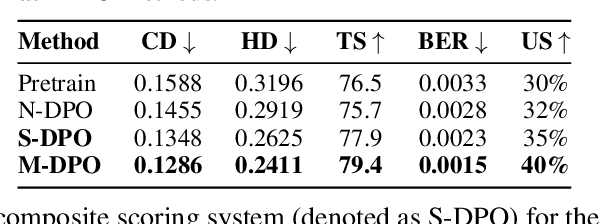
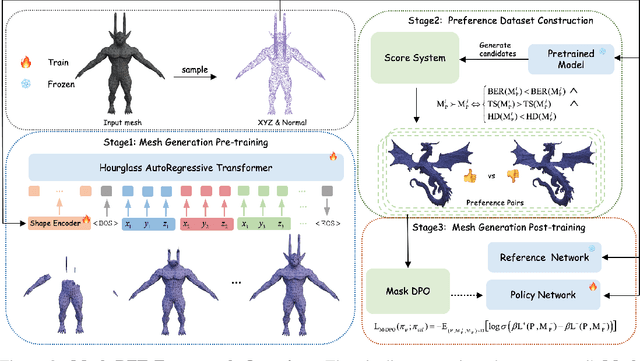
Abstract:Existing pretrained models for 3D mesh generation often suffer from data biases and produce low-quality results, while global reinforcement learning (RL) methods rely on object-level rewards that struggle to capture local structure details. To address these challenges, we present \textbf{Mesh-RFT}, a novel fine-grained reinforcement fine-tuning framework that employs Masked Direct Preference Optimization (M-DPO) to enable localized refinement via quality-aware face masking. To facilitate efficient quality evaluation, we introduce an objective topology-aware scoring system to evaluate geometric integrity and topological regularity at both object and face levels through two metrics: Boundary Edge Ratio (BER) and Topology Score (TS). By integrating these metrics into a fine-grained RL strategy, Mesh-RFT becomes the first method to optimize mesh quality at the granularity of individual faces, resolving localized errors while preserving global coherence. Experiment results show that our M-DPO approach reduces Hausdorff Distance (HD) by 24.6\% and improves Topology Score (TS) by 3.8\% over pre-trained models, while outperforming global DPO methods with a 17.4\% HD reduction and 4.9\% TS gain. These results demonstrate Mesh-RFT's ability to improve geometric integrity and topological regularity, achieving new state-of-the-art performance in production-ready mesh generation. Project Page: \href{https://hitcslj.github.io/mesh-rft/}{this https URL}.
FreeMesh: Boosting Mesh Generation with Coordinates Merging
May 19, 2025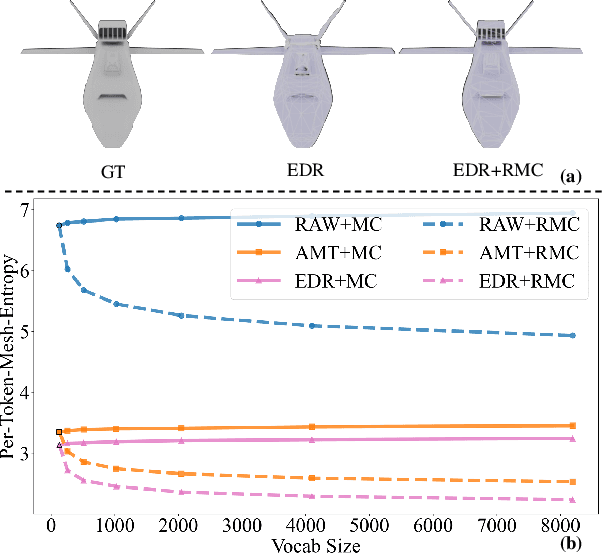
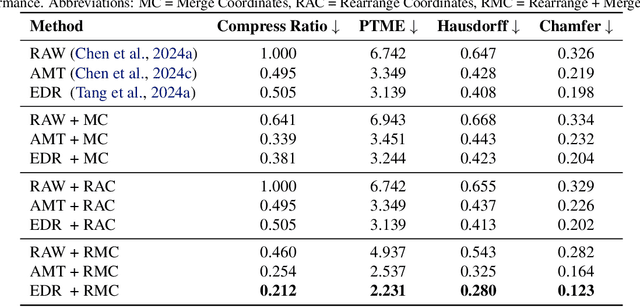
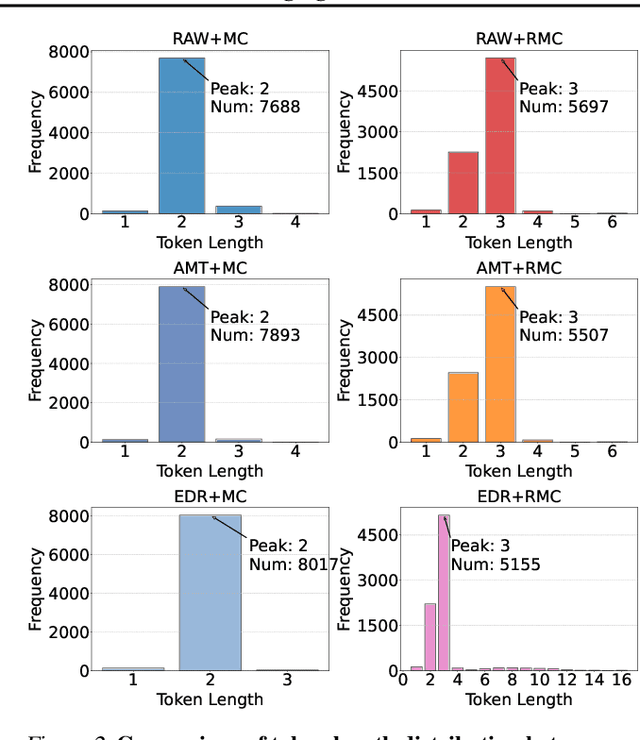

Abstract:The next-coordinate prediction paradigm has emerged as the de facto standard in current auto-regressive mesh generation methods. Despite their effectiveness, there is no efficient measurement for the various tokenizers that serialize meshes into sequences. In this paper, we introduce a new metric Per-Token-Mesh-Entropy (PTME) to evaluate the existing mesh tokenizers theoretically without any training. Building upon PTME, we propose a plug-and-play tokenization technique called coordinate merging. It further improves the compression ratios of existing tokenizers by rearranging and merging the most frequent patterns of coordinates. Through experiments on various tokenization methods like MeshXL, MeshAnything V2, and Edgerunner, we further validate the performance of our method. We hope that the proposed PTME and coordinate merging can enhance the existing mesh tokenizers and guide the further development of native mesh generation.
Event-Based Eye Tracking. 2025 Event-based Vision Workshop
Apr 25, 2025Abstract:This survey serves as a review for the 2025 Event-Based Eye Tracking Challenge organized as part of the 2025 CVPR event-based vision workshop. This challenge focuses on the task of predicting the pupil center by processing event camera recorded eye movement. We review and summarize the innovative methods from teams rank the top in the challenge to advance future event-based eye tracking research. In each method, accuracy, model size, and number of operations are reported. In this survey, we also discuss event-based eye tracking from the perspective of hardware design.
Edge Approximation Text Detector
Apr 05, 2025Abstract:Pursuing efficient text shape representations helps scene text detection models focus on compact foreground regions and optimize the contour reconstruction steps to simplify the whole detection pipeline. Current approaches either represent irregular shapes via box-to-polygon strategy or decomposing a contour into pieces for fitting gradually, the deficiency of coarse contours or complex pipelines always exists in these models. Considering the above issues, we introduce EdgeText to fit text contours compactly while alleviating excessive contour rebuilding processes. Concretely, it is observed that the two long edges of texts can be regarded as smooth curves. It allows us to build contours via continuous and smooth edges that cover text regions tightly instead of fitting piecewise, which helps avoid the two limitations in current models. Inspired by this observation, EdgeText formulates the text representation as the edge approximation problem via parameterized curve fitting functions. In the inference stage, our model starts with locating text centers, and then creating curve functions for approximating text edges relying on the points. Meanwhile, truncation points are determined based on the location features. In the end, extracting curve segments from curve functions by using the pixel coordinate information brought by truncation points to reconstruct text contours. Furthermore, considering the deep dependency of EdgeText on text edges, a bilateral enhanced perception (BEP) module is designed. It encourages our model to pay attention to the recognition of edge features. Additionally, to accelerate the learning of the curve function parameters, we introduce a proportional integral loss (PI-loss) to force the proposed model to focus on the curve distribution and avoid being disturbed by text scales.
Optimizing Case-Based Reasoning System for Functional Test Script Generation with Large Language Models
Mar 26, 2025Abstract:In this work, we explore the potential of large language models (LLMs) for generating functional test scripts, which necessitates understanding the dynamically evolving code structure of the target software. To achieve this, we propose a case-based reasoning (CBR) system utilizing a 4R cycle (i.e., retrieve, reuse, revise, and retain), which maintains and leverages a case bank of test intent descriptions and corresponding test scripts to facilitate LLMs for test script generation. To improve user experience further, we introduce Re4, an optimization method for the CBR system, comprising reranking-based retrieval finetuning and reinforced reuse finetuning. Specifically, we first identify positive examples with high semantic and script similarity, providing reliable pseudo-labels for finetuning the retriever model without costly labeling. Then, we apply supervised finetuning, followed by a reinforcement learning finetuning stage, to align LLMs with our production scenarios, ensuring the faithful reuse of retrieved cases. Extensive experimental results on two product development units from Huawei Datacom demonstrate the superiority of the proposed CBR+Re4. Notably, we also show that the proposed Re4 method can help alleviate the repetitive generation issues with LLMs.
TGP: Two-modal occupancy prediction with 3D Gaussian and sparse points for 3D Environment Awareness
Mar 13, 2025Abstract:3D semantic occupancy has rapidly become a research focus in the fields of robotics and autonomous driving environment perception due to its ability to provide more realistic geometric perception and its closer integration with downstream tasks. By performing occupancy prediction of the 3D space in the environment, the ability and robustness of scene understanding can be effectively improved. However, existing occupancy prediction tasks are primarily modeled using voxel or point cloud-based approaches: voxel-based network structures often suffer from the loss of spatial information due to the voxelization process, while point cloud-based methods, although better at retaining spatial location information, face limitations in representing volumetric structural details. To address this issue, we propose a dual-modal prediction method based on 3D Gaussian sets and sparse points, which balances both spatial location and volumetric structural information, achieving higher accuracy in semantic occupancy prediction. Specifically, our method adopts a Transformer-based architecture, taking 3D Gaussian sets, sparse points, and queries as inputs. Through the multi-layer structure of the Transformer, the enhanced queries and 3D Gaussian sets jointly contribute to the semantic occupancy prediction, and an adaptive fusion mechanism integrates the semantic outputs of both modalities to generate the final prediction results. Additionally, to further improve accuracy, we dynamically refine the point cloud at each layer, allowing for more precise location information during occupancy prediction. We conducted experiments on the Occ3DnuScenes dataset, and the experimental results demonstrate superior performance of the proposed method on IoU based metrics.
Transforming Weather Data from Pixel to Latent Space
Mar 09, 2025Abstract:The increasing impact of climate change and extreme weather events has spurred growing interest in deep learning for weather research. However, existing studies often rely on weather data in pixel space, which presents several challenges such as smooth outputs in model outputs, limited applicability to a single pressure-variable subset (PVS), and high data storage and computational costs. To address these challenges, we propose a novel Weather Latent Autoencoder (WLA) that transforms weather data from pixel space to latent space, enabling efficient weather task modeling. By decoupling weather reconstruction from downstream tasks, WLA improves the accuracy and sharpness of weather task model results. The incorporated Pressure-Variable Unified Module transforms multiple PVS into a unified representation, enhancing the adaptability of the model in multiple weather scenarios. Furthermore, weather tasks can be performed in a low-storage latent space of WLA rather than a high-storage pixel space, thus significantly reducing data storage and computational costs. Through extensive experimentation, we demonstrate its superior compression and reconstruction performance, enabling the creation of the ERA5-latent dataset with unified representations of multiple PVS from ERA5 data. The compressed full PVS in the ERA5-latent dataset reduces the original 244.34 TB of data to 0.43 TB. The downstream task further demonstrates that task models can apply to multiple PVS with low data costs in latent space and achieve superior performance compared to models in pixel space. Code, ERA5-latent data, and pre-trained models are available at https://anonymous.4open.science/r/Weather-Latent-Autoencoder-8467.
VQLTI: Long-Term Tropical Cyclone Intensity Forecasting with Physical Constraints
Jan 30, 2025



Abstract:Tropical cyclone (TC) intensity forecasting is crucial for early disaster warning and emergency decision-making. Numerous researchers have explored deep-learning methods to address computational and post-processing issues in operational forecasting. Regrettably, they exhibit subpar long-term forecasting capabilities. We use two strategies to enhance long-term forecasting. (1) By enhancing the matching between TC intensity and spatial information, we can improve long-term forecasting performance. (2) Incorporating physical knowledge and physical constraints can help mitigate the accumulation of forecasting errors. To achieve the above strategies, we propose the VQLTI framework. VQLTI transfers the TC intensity information to a discrete latent space while retaining the spatial information differences, using large-scale spatial meteorological data as conditions. Furthermore, we leverage the forecast from the weather prediction model FengWu to provide additional physical knowledge for VQLTI. Additionally, we calculate the potential intensity (PI) to impose physical constraints on the latent variables. In the global long-term TC intensity forecasting, VQLTI achieves state-of-the-art results for the 24h to 120h, with the MSW (Maximum Sustained Wind) forecast error reduced by 35.65%-42.51% compared to ECMWF-IFS.
SignEye: Traffic Sign Interpretation from Vehicle First-Person View
Nov 18, 2024Abstract:Traffic signs play a key role in assisting autonomous driving systems (ADS) by enabling the assessment of vehicle behavior in compliance with traffic regulations and providing navigation instructions. However, current works are limited to basic sign understanding without considering the egocentric vehicle's spatial position, which fails to support further regulation assessment and direction navigation. Following the above issues, we introduce a new task: traffic sign interpretation from the vehicle's first-person view, referred to as TSI-FPV. Meanwhile, we develop a traffic guidance assistant (TGA) scenario application to re-explore the role of traffic signs in ADS as a complement to popular autonomous technologies (such as obstacle perception). Notably, TGA is not a replacement for electronic map navigation; rather, TGA can be an automatic tool for updating it and complementing it in situations such as offline conditions or temporary sign adjustments. Lastly, a spatial and semantic logic-aware stepwise reasoning pipeline (SignEye) is constructed to achieve the TSI-FPV and TGA, and an application-specific dataset (Traffic-CN) is built. Experiments show that TSI-FPV and TGA are achievable via our SignEye trained on Traffic-CN. The results also demonstrate that the TGA can provide complementary information to ADS beyond existing popular autonomous technologies.
FengWu-W2S: A deep learning model for seamless weather-to-subseasonal forecast of global atmosphere
Nov 15, 2024Abstract:Seamless forecasting that produces warning information at continuum timescales based on only one system is a long-standing pursuit for weather-climate service. While the rapid advancement of deep learning has induced revolutionary changes in classical forecasting field, current efforts are still focused on building separate AI models for weather and climate forecasts. To explore the seamless forecasting ability based on one AI model, we propose FengWu-Weather to Subseasonal (FengWu-W2S), which builds on the FengWu global weather forecast model and incorporates an ocean-atmosphere-land coupling structure along with a diverse perturbation strategy. FengWu-W2S can generate 6-hourly atmosphere forecasts extending up to 42 days through an autoregressive and seamless manner. Our hindcast results demonstrate that FengWu-W2S reliably predicts atmospheric conditions out to 3-6 weeks ahead, enhancing predictive capabilities for global surface air temperature, precipitation, geopotential height and intraseasonal signals such as the Madden-Julian Oscillation (MJO) and North Atlantic Oscillation (NAO). Moreover, our ablation experiments on forecast error growth from daily to seasonal timescales reveal potential pathways for developing AI-based integrated system for seamless weather-climate forecasting in the future.
 Add to Chrome
Add to Chrome Add to Firefox
Add to Firefox Add to Edge
Add to Edge